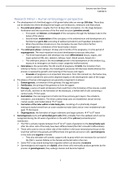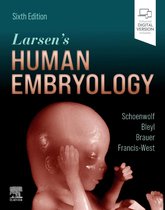Simone van den Oever
S1033271
Research Minor – Human embryology in perspective
• The development of a fertilized egg to a full-grown baby takes on average 266 days. These days
can be divided into three developmental stages: pre-embryonic, embryonic and fetal phase.
➢ Pre-embryonic phase is roughly the first 16 days after conception, it is the stage between
fertilization and the occurrence of the first axial structure (primitive streak)
o First week: cell division and transport of the conceptus through the fallopian tube to the
lumen of the uterus
o Second week: implantation of the conceptus in the endometrium and development of a
flat bilaminar germ disk consisting of epiblast (ectoderm) and hypoblast (entoderm)
o When the primitive streak occurs, the conceptus has axis that control further
morphogenesis: orientation of the future body is known
➢ The embryonic phase is between 16 days and 4 months of the pregnancy, it is the period of
organogenesis. The most important structural development processes take place
o The three-layered germ disk develops into more differentiated tissues, organs, and
organ systems (CNS, skin, skeleton, kidneys, heart, blood vessels, bowel etc.)
o The embryonic phase is the most critical period in the development of the embryo (e.g.,
exposure to teratogens can lead to major congenital malformations)
➢ Fetal phase is the period after the 4th month of pregnancy till birth, the transition from
embryo to foetus is not abrupt, the morphogenic processes will decrease slowly whereas this
process is replaced by growth and maturing of the tissues and organs
o 24 weeks of pregnancy is an important time point, from this moment on, the foetus may
survive outside the uterus (this depends largely on the development state of the lungs)
• The phases of human embryogenesis are generally recognized in 6 phases:
1. Gametogenesis, a formation of the gametes; the egg and sperm
2. Fertilization, the joining of the gametes to form the zygote
3. Cleavage, a series of rapid cell divisions that result first in the formation of the morula, a solid
ball of cells, and then in the formation of the blastocyst, a hollow ball of cells containing a
central cavity → first week
4. Gastrulation, the rearrangement of cells into three primary germ layers: the ectoderm,
mesoderm, and endoderm. The three cardinal body axes are established: dorsal-ventral,
cranial-caudal, and medial-lateral → 2nd week
5. Formation of the tube-within-a-tube body plan, consisting of a cylindrically shaped
embryonic body formed from an outer ectodermal tube (skin) and an inner endodermal tube
(gut) → third week
6. Organogenesis, the formation of organ rudiments and organ systems → 4th to 8th week
• Gametogenesis starts with primordial germ cells (PGC, probably from the epiblast) which can be
recognized during the 4h week of gestation in the wall of the yolk sac (extraembryonic
membrane)
➢ The PGC’s actively migrate between the 6th & 12th week of gestation to the dorsal body wall,
after the other cells of the body have been differentiated (the PGC’s shouldn’t differentiate)
➢ These cells come to rest on either side of the midline in the loose mesenchymal tissue at the
level that will form the gonads and differentiate into gamete precursor cells: spermatogonia
in the male and oogonia in female
o They also stimulate cell somatic support cells to grow which are necessary for survival of
the PGC’s: ovarian follicles in the female and Sertoli cells in the man
➢ Some PGC’s may strand during their migration which can become a teratoma
➢ Spermatogonia and oogonia are diploid, when these cells eventually produce gametes by the
process of gametogenesis, they undergo meiosis and become haploid
1
, Simone van den Oever
S1033271
• Timing of gametogenesis in males and females
different:
➢ In males, PGC’s (now gonocytes) remain
dormant until puberty. During puberty,
seminiferous tubules mature and gonocytes
differentiate into spermatogonia, which
undergo meiosis and mature into
spermatozoa. Spermatozoa are produced
from puberty till death
➢ In females gonocytes undergo a few mitotic
divisions during the embryonic phase, until the
differentiate into oogonia. By the 5th month
the oogonia all undergo meiosis after which
they become primary oocytes. During puberty,
a few ovarian follicles resume development
every month, usually only one primary oocyte
matures into a secondary oocyte and ovulates
• Difference between ploidy and N-number:
➢ Ploidy refers to the numer of copies of each
chromosome present in a cell nucleus
➢ N numer refers to the number of copies of
each unique double-stranded DNA molecule in
the nucleus
• During puberty testosterone stimulates commencement of spermatogenesis and Sertoli cells
differentiate into a system of seminiferous tubules. The PGC’s develop into spermatogonia after
several divisions of mitosis.
➢ Cells that undergo spermatogenesis move from the basal to the luminal side of the Sertoli
cell, during which they undergo both meiotic divisions and d become four spermatids
➢ These spermatids are converted into mature sperm = spermiogenesis with the help of Sertoli
cells: the plasm shrinks, they change shape into head, midpiece and tail, and finally they are
release from the Sertoli cell =spermiation
➢ The head contains the condensed nucleus and is surround by a vesicle, the acrosome, which
is essential for fertilization
➢ Spermatogenesis takes place till death, one cycle takes about 64 days (2 months)
➢ Sperm is stored in the epididymis and released through the vas deferens and urethra, where
it is mixed with nourishing secretions form the seminal vesicles, prostate, and bulbourethral
glands. Sperm survives 1 to 3 days in ampulla where it can fertilize an oocyte
2
, Simone van den Oever
S1033271
• After primary oocytes are developed during the 12th week of development of the embryo, they
are stored in a germinal vesicle which is enclosed, protected, and formed into a primordial
follicle
➢ After the menarche, the menstrual cycle is repeated monthly until the menopause starts, at 5
months you have 7.000.000 oocytes, at birth 700.000, but only 400 will ovulate eventually
➢ Before a particular cycle, a small group of primordial follicles (5-12) thickens, surrounding the
oocyte by a layer of cuboidal cells =zona pellucida, they become primary follicles
➢ With the rising levels of FSH during the cycle some follicles enlarge and take up fluid (become
a vesicular follicle) whereas others degenerate.
➢ Finally, only one mature vesicular follicle
remains, the oocyte has not resumed meiosis
➢ Around day 14, the rising levels of FSH and LH stimulate the oocyte to resume meiosis, which
is stopped again right before ovulation during the second meiotic metaphase
➢ The follicle moves to the surface of the ovary, due to tension from smooth muscle cells in the
follicle walls and other factors by fibroblasts the follicle bursts open slowly
o Some people feel the ovulation because the oocyte moves along the peritoneum
➢ The oocyte moves to the ampulla and remains viable for 24 hours
➢ The follicular wall proliferates to the corpus luteum which stimulates progesterone
production. When no embryo implants, the corpus luteum shrinks and the thickened
endometrium degenerates = menstrual phase
• A viable spermatozoon which reaches the tough zona pellucida,
binds with a glycoprotein sperm receptor in the zona, as a result
the acrosome is induced to release degradative enzymes which
allow the sperm to penetrate through the zona pellucida
➢ The zona pellucida only allows species-specific fertilization,
prevents polyspermy, it prevents cell blastomeres to
dissociate and prevents premature implantation
o Furthermore, it enables the acrosome reaction and
provides the oocyte with nutrients
➢ If this happens successfully the membranes fuse together, inducing two processes
preventing other sperm cells to enter the oocyte: formation of a calcium wave over the
surface of the egg and release of small cortical granules into the perivitelline space (between
the oocyte and the zona pellucida)
➢ Fertilization by two spermatozoa or no formation of the third polar body (2 blue and 1 red
split) in the oocyte can lead to triploids (most of the time not viable)
➢ Other mistakes during gametogenesis can lead to monosomy or trisomy (Down, Edwards)
➢ After fusion, the oocyte is induced to resume meiosis, after which a definitive oocyte and a
polar body remains. The nuclei of the oocyte and sperm swell within the now zygote and are
female and male pronuclei
➢ Paternal and maternal chromosomes are replicated in preparation for the first cleavage
3
, Simone van den Oever
S1033271
• Within 24 hours after fertilization the zygote initiates a rapid series of mitotic cell divisions called
cleavage. There is no cell growth only division of cells into blastomeres, after 4 days the embryo
consists of 16 to 32 cells, it is now called a morula.
➢ The morula is divided into two groups: a peripheral outer cell layer, the trophoblasts, which
forms the fetal components of the placenta and extraembryonic membranes, and a central
inner cell mass, the embryoblast, which forms the embryo proper.
➢ As the trophoblast differentiates, tight, gap and adherens junctions as well as desmosomes
are formed between adjacent cells with help of E-cadherine and form a smooth surface
➢ A polarize membrane with an ion-exchange ATP-pump is formed, via osmosis the blastocyst
cavity fills with fluid and the embryoblast forms a compact mass on one side (=blastocyst) →
embryonic pole and abembryonic pole is formed
• After 5 days, the blastocyst enters the uterus and hatches from the zona pellucida, the blastocyst
can now directly interact with the endometrium: it becomes tightly adherent to the uterine lining.
➢ The adjacent cells of the endometrial stroma differentiate into metabolically active
secretory cells (lipid and glycogen), decidual cells (=decidual reaction, with help of the
progesterone production from CL.)
➢ The trophoblast cells produce human chorionic gonadotropin (hCG) supporting the
corpus luteum to secrete sex steroids for progesterone
• At the end of the first week, the trophoblast at the embryonic pole proliferates into a
synctiotrophoblast on the outside (where lacunae are formed), and the cytotrophoblast which
lies against the blastocyst. →
➢ At the beginning of the 2nd week, the embryoblast splits into the epiblast (blue) and the
hypoblast (primitive endoderm, yellow). An extracellular basement membrane divides
these two cell layers making it a bilaminar
blastoderm. With this formation, the primitive
dorsal-ventral axis of the embryo is defined
➢ An amniotic cavity occurs between the epiblast and
overlying trophoblast, the membrane lining the
amnion is one of the 4 extraembryonic membranes.
o Being: amnion, chorion, yolk sac and allantois
o By the 8th week, the amnion encloses the entire
embryo -> amniotic sac
➢ Between days 6 and 9 the embryo becomes fully implanted in the endometrium with help
of proteolytic enzymes produced by the cytotrophoblast who breakdown the extracellular
matrix between endometrial cells.
• During the second week, the hypoblast sends out two waves of migratory endodermal cells in
the blastocyst cavity: the first wave forms the primary yolk sac (extra coelomic membrane) and
the second transforms the primary yolk sac into the secondary yolk sac
➢ The extraembryonic mesoderm splits into two layers forming the chorionic cavity, this
extraembryonic coelom separates the embryo with amnion and yolk sac from the outer wall
of the blastocyst (=chorion), it only stays connected via the connecting stalk
o Function amniotic sac: protect fetus from injury, prevents dehydration and regulate
temperature of the foetus (in birds)
o Function chorion: surrounds the yolk and the embryo, develop villi and the placenta, in
birds they exchange gases between embryo and surrounding air
➢ The definitive yolk sac is a two-layered structure consisting of an endoderm on the inside
and mesoderm on the outside, the mesoderm is important for haematopoiesis, and
primordial germ cells can be found here (storage). Furthermore, it surrounds the yolk and
mediates nutrition during development
➢ The yolk sac normally disappears before birth in rare occasions it persists as a digestive tract,
called a Meckel’s diverticulum
4






